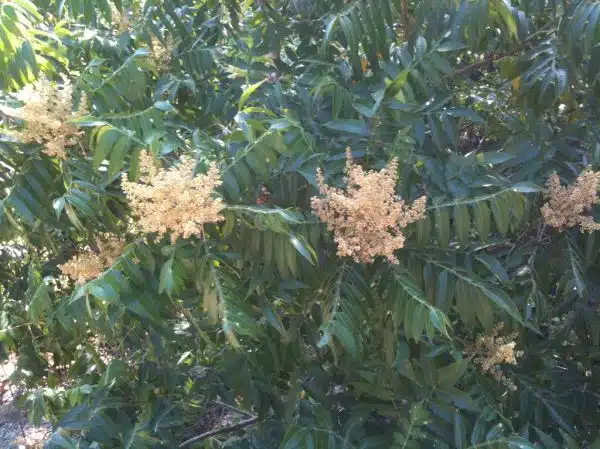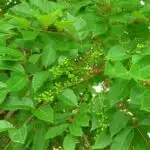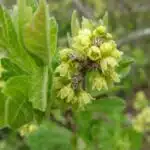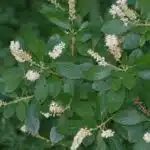The Smooth Sumac, commonly known as Rhus glabra, is a species of deciduous shrub that belongs to the Anacardiaceae family. It is native to North America and can be found growing in various habitats such as prairies, savannas, and woodland edges. The Smooth Sumac is a hardy plant that provides multiple benefits to humans and wildlife, making it an excellent addition to any garden or landscape.
In this article, we will discuss how to grow and care for the Smooth Sumac. We will cover important topics such as soil requirements, watering needs, pruning techniques, and pest control methods. By following these guidelines, you can ensure that your Smooth Sumac thrives and adds value to your environment. Whether you are a seasoned gardener or a novice plant enthusiast, this article will provide you with valuable insights into cultivating and maintaining this beneficial shrub.
Overview Of The Smooth Sumac
Smooth sumac, also known as Rhus glabra, is a deciduous shrub that is native to North America. It can grow up to 20 feet tall and 30 feet wide, with erect stems that bear large compound leaves. One interesting statistic about smooth sumac is that it has been used by Native Americans for medicinal purposes for centuries. They would brew the leaves and bark into a tea to treat ailments such as diarrhea, sore throat, and fever.
In addition to its medicinal uses, smooth sumac has a rich history of being utilized for various purposes. The plant’s red berries were used by Native Americans to make a lemonade-like drink that was consumed both fresh and dried. These berries have also been used in the production of dyes, as they yield a red color when crushed. Moreover, the plant’s wood was once commonly used for fence posts due to its durability.
Today, smooth sumac remains an important species in horticulture due to its ornamental qualities and ecological benefits. Its striking foliage turns brilliant shades of orange and red in the fall, making it an attractive landscaping option. Additionally, the plant’s ability to fix nitrogen in soil makes it a valuable asset in restoring disturbed ecosystems. In the next section, we will discuss the benefits of growing smooth sumac and how you can care for this versatile shrub.
Benefits Of Growing Smooth Sumac
Smooth sumac is a deciduous shrub that belongs to the Anacardiaceae family. It is native to North America and can grow up to 15 feet tall with a spread of 20 feet. This plant is well-known for its ornamental value, as it produces beautiful clusters of red berries in late summer that turn into deep red in autumn. In addition, smooth sumac is drought tolerant and easy to grow, making it an excellent choice for gardeners who want to add some color and texture to their landscape.
There are several health benefits associated with the smooth sumac fruit. The berries are rich in antioxidants, which help protect the body against damage from free radicals. Additionally, they have been used for centuries by Native Americans as a natural remedy for various ailments such as diarrhea, sore throat, and fever. Furthermore, the bark of the smooth sumac contains tannins that can be used to treat skin irritations such as rashes and burns.
Culinary uses of smooth sumac include using the berries to make tea or lemonade-like beverages that are refreshing on hot summer days. The dried berries can also be used as a spice in cooking and baking, adding a tangy flavor similar to lemon or vinegar. Moreover, the leaves of this plant can be used fresh or dried as a seasoning for meats or vegetables.
Smooth sumac is an excellent addition to any garden due to its many benefits. As previously mentioned, it is easy to grow and care for, making it an ideal option for novice gardeners. Its ornamental value adds color and texture to any landscape while its health benefits make it an important addition to any herb garden or medicinal collection. The culinary uses of this plant add versatility in cooking and baking while providing unique flavors not found in other spices. In the next section, we will discuss climate and growing conditions necessary for successful growth of smooth sumac plants in your garden.
Climate And Growing Conditions
Like many other plants, smooth sumac’s growth and survival depend on the climate and growing conditions. The plant has a wide geographic distribution in North America, from the eastern United States to Canada, and can thrive in diverse habitats such as woodlands, prairies, and roadsides. Smooth sumac is a deciduous shrub that grows up to 20 feet tall with a spread of up to 30 feet. Its leaves turn bright red in autumn, adding beauty to any landscape.
The smooth sumac’s growing season typically begins in the late spring or early summer when temperatures warm up. It prefers full sun exposure but can tolerate partial shade. The plant requires moderate moisture levels and can withstand periods of drought once established. During the winter months, smooth sumac’s branches provide an excellent source of food for wildlife.
In summary, understanding the climate and growing conditions is crucial for successful cultivation of smooth sumac. The plant’s adaptability to different habitats makes it an attractive option for various landscaping projects. In the next section, we will explore soil requirements for smooth sumac cultivation, which are equally important for its growth and survival.
Soil Requirements For Smooth Sumac
Smooth sumac is a hardy shrub that can grow in various climates and growing conditions. However, it thrives best in areas with full sun exposure and well-draining soil. The ideal temperature range for smooth sumac growth is between 60 to 85°F, but it can tolerate both high and low temperatures.
Soil preparation is crucial for the healthy growth of smooth sumac. The pH level of the soil should be between 4.5 to 7.5, which is slightly acidic to neutral. Adding organic matter like compost or leaf mold helps improve soil structure and fertility. Best fertilizers for smooth sumac are slow-release fertilizers that contain equal amounts of nitrogen, phosphorus, and potassium.
Here are some tips for preparing the soil for smooth sumac:
- Clear the planting area of debris like rocks, weeds, or roots.
- Loosen the soil to a depth of at least 12 inches using a tiller or garden fork.
- Mix organic matter into the loosened soil until it’s well blended.
With proper soil preparation techniques, you can ensure that your smooth sumac will have all the necessary nutrients to thrive and produce robust foliage and flowers. In the next section, we’ll discuss watering needs and irrigation methods for this resilient shrub.
Watering Needs And Irrigation
Smooth sumac requires a consistent watering schedule to grow and thrive. It is necessary to ensure that the soil remains moist but not waterlogged, as overwatering can lead to root rot. During the plant’s first year, it is essential to keep the soil consistently moist until it is well-established. Once established, the plant can survive with less frequent watering.
Drip irrigation is an efficient way of watering smooth sumac. It provides slow, steady dripping of water directly onto the base of the plant, allowing the soil to absorb moisture gradually without waterlogging. Drip irrigation also helps conserve water by reducing evaporation and runoff. It is recommended to install a drip-irrigation system during planting, which will save time and effort in the long run.
To determine the appropriate watering schedule for your smooth sumac, consider various factors such as climate, soil type, and humidity levels. A good rule of thumb is to water deeply once a week during dry spells or drought conditions. However, be sure not to overwater as this can lead to root rot and other fungal diseases. It’s important to monitor soil moisture regularly by checking the topsoil with your finger or a moisture meter before watering again.
Moving on from watering needs and irrigation practices for smooth sumac, it’s crucial to understand how fertilization plays an essential role in its growth and development. A proper fertilizer application ensures that your smooth sumac receives adequate nutrients necessary for healthy foliage growth and overall survival.
Fertilizer Application
Smooth Sumac is a hardy, drought tolerant shrub that can be successfully grown in most regions. For optimal growth, using the correct type of fertilizer, amount of fertilizer, and timing of fertilizer application are key. Organic fertilizers, such as compost, manure or fish emulsion, can be used to add necessary nutrients to the soil. Chemical fertilizers, such as 10-10-10 or 20-20-20, can also be used for the same purpose. The amount of fertilizer will depend on the soil texture, nutrient content and water availability. Generally, an application rate of 1 to 2 pounds per 100 square feet is recommended. The timing of fertilizer application is best done during spring, right before the plant begins actively growing.
Types Of Fertilizer
To ensure the optimum growth and health of smooth sumacs, choosing the best fertilizer is essential. The type of fertilizer you select will directly impact the plant’s growth and overall health. While there are many options available in the market, it’s crucial to choose the right one for your specific needs.
The best fertilizer for smooth sumac is one that has a balanced ratio of nitrogen, phosphorus, and potassium. Nitrogen supports foliage growth, phosphorus encourages root development, while potassium enhances disease resistance and stress tolerance. Organic options such as compost or manure can also be used as fertilizers for smooth sumacs. These organic choices offer additional benefits by improving soil structure and promoting beneficial microorganisms.
It’s important to note that over-fertilizing can cause more harm than good to your smooth sumac plant. Over-fertilization can lead to excessive foliage growth at the expense of root development or even cause salt buildup in the soil leading to stunted growth. Therefore, it’s crucial to use fertilizers in moderation and follow recommended application rates. With proper application of suitable fertilizers, your smooth sumac will thrive and make a beautiful addition to your landscape design.
Amount Of Fertilizer
When it comes to fertilizing smooth sumacs, not only is choosing the right type of fertilizer important but also the amount of fertilizer applied. Over-fertilization can lead to negative consequences such as stunted growth or even plant death. Therefore, it’s crucial to apply fertilizers in moderation and follow recommended application rates.
One common mistake in fertilizer application is applying too much fertilizer at once. This can lead to a buildup of salts in the soil, causing damage to the plant’s roots and leading to stunted growth or even death. It’s essential to follow the recommended application rates on the fertilizer package and not exceed them.
Another factor that affects the amount of fertilizer required is the type of fertilizer used. Organic fertilizers such as compost or manure release nutrients slowly over time, while chemical fertilizers release nutrients quickly. Therefore, organic fertilizers require larger amounts to achieve similar results as chemical ones. It’s important to note that organic fertilizers offer additional benefits such as improving soil structure and promoting beneficial microorganisms that are beneficial for plant growth.
Timing Of Fertilizer Application
Fertilizer application is a crucial aspect of smooth sumac growth. As mentioned earlier, the right amount and type of fertilizer are essential for optimal plant health. However, the timing of the fertilizer application is also another critical factor to consider. The best time to apply fertilizer to smooth sumacs is during their active growing season.
The active growing season for smooth sumacs usually begins in early spring and lasts until late summer or early fall. During this period, the plants require adequate nutrients to support their growth and development. Therefore, it’s recommended to apply fertilizers at the beginning of this period to ensure that the plants receive sufficient nutrients throughout their growing season.
When it comes to choosing the best type of fertilizer for smooth sumac growth, slow-release fertilizers are highly recommended. Slow-release fertilizers release nutrients gradually over an extended period, providing a steady supply of nutrients that last longer than fast-release fertilizers. Additionally, organic fertilizers such as compost or manure are also an excellent option for smooth sumac growth as they improve soil structure and promote beneficial microorganisms that support plant growth. Overall, understanding when and what type of fertilizer to use can significantly impact smooth sumac growth and overall health.
Pruning Techniques For Smooth Sumac
After providing adequate nutrition to the smooth sumac through the application of fertilizer, attention should be given to pruning techniques for the maintenance of a healthy and attractive plant. Pruning is an essential aspect of smooth sumac care, which not only enhances its aesthetic appeal but also promotes optimal growth and development. The process involves removing unwanted or diseased branches to stimulate new growth and maintain the structural integrity of the plant.
When it comes to pruning techniques for smooth sumac, branch management is a critical consideration. It is advisable to remove any dead or damaged branches as soon as they are noticed. This helps prevent the spread of disease and pests that may cause harm to other parts of the plant. Additionally, pruning can be done to manage the size and shape of the smooth sumac. To accomplish this, selectively cut back young shoots in early spring or late winter when they are still tender.
Pruning techniques for smooth sumac should also include thinning out crowded areas by cutting back some branches entirely. This allows more air circulation and light penetration into the plant’s interior, which promotes overall health and vigor. Thinning can be done annually or biennially, depending on how fast the tree grows. By employing these pruning techniques, one can ensure a healthy and thriving smooth sumac that will enhance any landscape garden. In the subsequent section about transplanting and propagation, we will discuss ways to propagate your smooth sumac through various methods such as seed collection or root division.
Transplanting And Propagation
Propagation techniques for smooth sumac include both seed propagation and vegetative propagation. To propagate from seeds, collect them in the fall and store them in a cool, dry place until spring. In early spring, sow the seeds in containers or directly into the ground. Germination can take up to several weeks, so be patient. Alternatively, vegetative propagation techniques such as root cuttings or layering can also be used to propagate smooth sumac.
When transplanting smooth sumac, it is important to manage transplant shock carefully. Choose a new location that is similar in soil type and sun exposure to the original location of the plant. Before transplanting, water the plant thoroughly to help reduce shock during and after transplantation. Dig a hole that is wider than the root ball of the plant and gently loosen any tangled roots before placing it in the new hole. Water thoroughly after planting and continue to monitor moisture levels regularly for several weeks after transplanting.
Propagation Techniques:
- Collect seeds in fall and sow in early spring
- Use vegetative propagation techniques such as root cuttings or layering
- Be patient as germination can take several weeks
- Monitor moisture levels carefully
Incorporating these propagation techniques and careful transplant shock management will ensure successful growth of your smooth sumac plant. In the next section, we will discuss common pests and diseases that may threaten your plant’s health and how to prevent them from causing damage or hindering growth.
Common Pests And Diseases
Scale Insects are a common pest of Smooth Sumac, and can cause defoliation and branch dieback if left untreated. Leaf Spot Disease can cause yellow or brown spots on the foliage of Smooth Sumac, and can be treated with a fungicide. Spider Mites are another common pest of Smooth Sumac, and can cause yellow stippling or webbing on the leaves. To prevent pests and diseases, it is important to maintain proper cultural conditions and to inspect plants regularly for signs of infestation. Pruning and removing infected leaves and branches can help control the spread of diseases and pests. Finally, applying a preventative spray can also help control pests and diseases on Smooth Sumac.
Scale Insects
Scale insects are small, sap-sucking insects that can cause significant damage to the smooth sumac. They usually attach themselves to the stems, leaves, and fruits of the plant and feed on its sap. These pests secrete a sticky substance called honeydew, which attracts ants and promotes the growth of sooty mold.
Integrated pest management is an effective way of controlling infestations of scale insects in your smooth sumac. It involves the use of natural predators like ladybugs and lacewings that feed on these pests. You can also prune any heavily-infested branches and treat the affected areas with insecticidal soap or horticultural oil.
Regular monitoring and early detection are crucial for preventing scale insect infestations from becoming severe. Be sure to inspect your smooth sumac regularly for signs of these pests, such as yellowing or wilting leaves, stunted growth, or honeydew secretion. With proper care and attention, you can keep your smooth sumac healthy and free from scale insect damage.
Leaf Spot Disease
As a horticultural expert, it is essential to know the common pests and diseases that can affect your smooth sumac. One of the most prevalent diseases is leaf spot disease, caused by fungal pathogens. This disease affects the leaves of the plant, causing small, circular or irregular-shaped spots that vary in color from brown to black. If left untreated, these spots can merge, causing the leaves to yellow and drop prematurely.
Prevention is key in avoiding leaf spot disease in your smooth sumac. Ensure that your plant has good air circulation and avoid overhead watering as this can promote the growth of fungal spores on the leaves. Additionally, keep your plant healthy by providing it with adequate water and nutrients. Regularly remove any fallen leaves or debris from around your plant to minimize the chances of infection.
If you notice signs of leaf spot disease on your smooth sumac, prompt treatment is necessary to prevent further damage. Remove any affected leaves and dispose of them properly; do not add them to compost as this can spread the fungal spores. You may also consider using fungicidal sprays or treatments recommended by a horticulturist to control the spread of infection. Remember that early detection is crucial for effective treatment of leaf spot disease in your smooth sumac.
Spider Mites
Smooth sumac plants are susceptible to a range of pests and diseases that can impact their growth and overall health. In this article, we will discuss one of the most common pests that affect smooth sumac plants – spider mites. Spider mites are tiny arachnids that feed on the sap of plants, causing damage to the leaves and stems. They are known to infest smooth sumac plants in large numbers, making it important for horticulturists to understand how to identify and control these pests effectively.
Spider mites are known to cause significant damage to the leaves of smooth sumac plants by piercing them with their mouthparts and sucking out the sap. This can result in yellowing or browning of the leaves, premature leaf drop, and stunted growth. To prevent spider mites from infesting your smooth sumac plant, it is essential to maintain good hygiene practices such as removing any dead or diseased leaves from around the plant regularly. Additionally, you can use preventive measures like spraying neem oil or insecticidal soap on your plant as they repel spider mites.
If you suspect that your smooth sumac plant has been infested with spider mites, prompt mitigation techniques must be employed immediately. One way is by using a strong jet of water aimed at the underside of the leaves where spider mites tend to congregate. This will dislodge them from their feeding sites and wash them away. Another effective method is using miticides that kill spider mites while being safe for your plant if applied correctly. Horticulturists also recommend pruning heavily-infested branches completely as they may not recover fully even after treatment. By employing appropriate prevention methods and mitigation techniques, you can ensure that your smooth sumac remains healthy and free from spider mite infestations.
Natural Pest Control Methods
To effectively care for your smooth sumac, it is important to be aware of potential pests that could harm the plant. While chemical pest control methods are available, there are also natural alternatives that can be just as effective without harming the environment. These methods include using natural pest repellents and companion planting techniques.
Natural pest repellents can help keep unwanted insects away from your smooth sumac. Some examples of natural repellents include garlic, neem oil, and hot pepper spray. These repellents work by deterring insects with their strong odor or taste, making them less likely to feed on your plant. You can easily make your own natural repellent at home or purchase them from a gardening store.
Companion planting involves strategically placing certain plants near your smooth sumac to deter pests and promote growth. For example, planting marigolds near your sumac can help repel harmful insects while attracting beneficial ones like ladybugs. Additionally, planting herbs such as basil and mint near your sumac can help improve its overall health and deter pests due to their strong scent. Implementing companion planting techniques can provide a sustainable approach to caring for your smooth sumac while also promoting biodiversity in your garden.
Transition: While these natural pest control methods can be effective, there may be instances where chemical pest control is necessary. In the next section, we will explore some common chemical pest control methods used in horticulture and their potential impact on the environment.
Chemical Pest Control Methods
Natural pest control methods are a popular alternative to harsh chemicals that can harm both the environment and beneficial insects. Organic alternatives, including companion planting and physical barriers, can be effective in deterring pests from damaging crops. Additionally, Integrated Pest Management (IPM) is a holistic approach that focuses on prevention rather than eradication. This method involves identifying the type of pest and using a combination of techniques to manage them.
Companion planting involves growing plants that naturally repel pests next to those that are susceptible to them. For example, marigolds are known to deter aphids when planted near tomatoes or peppers. Physical barriers such as row covers or netting can also be used to prevent pests from accessing crops. IPM involves monitoring for pests and implementing preventative measures before they become a problem. This may include crop rotation, sanitation practices, and the use of natural predators.
While chemical pesticides may seem like an easy solution, they often have negative impacts on the environment and non-target species. Organic alternatives and IPM methods not only reduce the use of harmful chemicals but also promote long-term sustainability in agriculture. By implementing these practices, gardeners can protect their crops while minimizing ecological damage.
Moving forward with our discussion on smooth sumac care, let’s now focus on harvesting and use of smooth sumac fruit.
Harvesting And Use Of Smooth Sumac Fruit
The smooth sumac fruit is a valuable resource for both culinary and medicinal purposes. In fact, Native American tribes have utilized the fruit for centuries as a food source and medicine. The bright red berries are rich in vitamin C, antioxidants, and other beneficial compounds.
One interesting statistic about smooth sumac fruit is that it contains more antioxidants than blueberries, which are widely known for their antioxidant properties. This makes it an excellent addition to any diet or health regimen. To make sumac tea, simply steep the berries in hot water for several minutes. Sumac tea has a tangy flavor and is often used as a natural remedy for colds and sore throats.
Another popular use of smooth sumac fruit is in spice blends. The berries can be dried and ground into a powder to add flavor to dishes such as salads, meats, and vegetables. Sumac spice blends are commonly used in Middle Eastern cuisine, where they are added to dishes such as hummus and kebabs. The tangy flavor of the spice adds depth to these dishes and makes them stand out.
In summary, smooth sumac fruit is not only easy to grow and care for but also provides numerous benefits. Whether you choose to make tea or use it in spice blends, incorporating this versatile plant into your diet can promote good health while adding delicious flavor to your meals. However, there are other uses of smooth sumac that you should know about as well.
Other Uses Of Smooth Sumac
After harvesting the smooth sumac fruit, there are other uses for this versatile plant. One common use is in edible recipes. The tart and citrusy flavor of the fruit can be used to make a refreshing tea or lemonade. It can also be dried and ground into a spice that adds a unique flavor to dishes such as roasted vegetables or grilled meats.
In addition to its culinary uses, smooth sumac has been used for medicinal purposes for centuries. The leaves and bark contain compounds that have anti-inflammatory and antioxidant properties, making it useful for treating conditions such as arthritis and digestive issues. Additionally, the plant has been used topically to treat skin irritations and infections.
Overall, smooth sumac is a valuable plant with many uses beyond just its ornamental value in landscaping. Whether you want to incorporate it into your diet or try out its medicinal properties, this plant is worth considering for its practical applications.
Transitioning into the next section about landscaping with smooth sumac, it’s important to note that this plant can also add beauty and interest to your outdoor space. With its vibrant fall color and interesting texture, smooth sumac makes an excellent addition to naturalized areas or as a focal point in mixed borders.
Landscaping With Smooth Sumac
- Planting Smooth Sumac is best done in early spring or fall to allow ample time for the shrub to become established.
- Plant Smooth Sumac in a sunny location with well-draining soil for optimal growth.
- Pruning Smooth Sumac should be done in late winter or early spring before new growth begins.
- Prune Smooth Sumac by removing dead, damaged, or diseased branches and by thinning out the shrub to improve air circulation and maintain a desired size and shape.
Planting Smooth Sumac
Are you looking to add some vibrant color and texture to your landscape? Consider the smooth sumac, a hardy shrub that’s easy to grow and care for. To ensure its success, it’s important to choose the best locations for planting and follow some essential planting tips.
The smooth sumac thrives in full sun, making it an ideal choice for open fields or sunny spots in your yard. It can tolerate a range of soil types, from sandy to clayey, as long as it’s well-drained. Avoid planting in areas with poor drainage or standing water.
When planting smooth sumac, it’s best to do so in the spring or fall when temperatures are mild. Dig a hole twice as wide as the root ball but no deeper than the top of the root ball. Place the plant in the hole and backfill with soil, gently packing it down around the roots. Water thoroughly and mulch with 2-3 inches of organic material to help retain moisture and suppress weeds.
By selecting appropriate locations and following proper planting techniques, you can enjoy the beauty of smooth sumac in your landscape for years to come. Remember to provide regular water during dry spells and prune as needed to maintain its shape and size. Happy gardening!
Pruning Smooth Sumac
When it comes to maintaining the beauty of smooth sumac in your landscape, pruning is an essential task. Pruning helps to promote healthy growth, maintain a desirable shape and size, and remove any damaged or diseased branches. The frequency of pruning depends on your desired outcome and the age of the plant.
For young smooth sumac plants, pruning can help establish a strong framework and encourage branching. It’s best to prune these plants lightly in the first two years after planting, removing any dead or crossing branches. As the plant matures, you may need to prune more frequently to control its size or shape.
When pruning smooth sumac, it’s important to use the proper tools for the job. Sharp bypass pruners are ideal for cutting small branches up to ½ inch thick, while loppers are better suited for larger branches up to 2 inches thick. Make cuts just above a bud or branch junction at a slight angle and avoid leaving stubs that can attract pests and diseases. With proper pruning techniques, you can keep your smooth sumac looking healthy and vibrant for years to come.
Frequently Asked Questions About Smooth Sumac
The smooth sumac is a unique plant that has captured the interest of many gardeners and horticultural enthusiasts. Its vibrant red color and ability to thrive in various environmental conditions make it an excellent addition to any landscape design. This deciduous shrub grows up to 20 feet tall and can spread up to 30 feet wide, making it an excellent choice for large areas.
One of the most distinctive features of the smooth sumac is its berries. The berries are bright red and covered in small hairs, giving them a velvety texture. These berries have been used for centuries as a food source, with many cultures using them to make teas, jams, and other culinary delights. Additionally, sumac berries have been used in traditional medicine as a remedy for various ailments such as fever, diarrhea, and sore throats.
Sumac is also known for its ornamental value in landscaping. The plant’s stunning red color makes it an excellent choice for fall foliage displays, where it can create a striking contrast against other plants’ greenery. Furthermore, the plant’s dense growth pattern makes it ideal for creating natural barriers or providing shade during hot summer months. With its versatile uses and aesthetic appeal, the smooth sumac is undoubtedly a valuable addition to any garden or landscape design project.
In conclusion, growing and caring for the smooth sumac requires some knowledge of its unique characteristics and needs. However, once established in your landscape design project’s right location, this plant can provide years of visual enjoyment while also offering potential culinary or medicinal benefits through its berries. Whether you’re looking to create natural barriers or add bold colors to your garden’s fall foliage display, the smooth sumac may be just what you need!
Conclusion
Smooth sumac is a versatile and hardy shrub that can add both beauty and usefulness to any landscape. With proper care, it can thrive in a range of climates and soil conditions, providing an abundance of fruit that can be used for culinary purposes or processed into a variety of products. Whether you’re looking to attract wildlife, stabilize soil, or simply enjoy the beauty of this native plant, growing smooth sumac is a rewarding endeavor.
In conclusion, the smooth sumac is truly an exceptional plant that offers both practical benefits and aesthetic appeal. Its feathery leaves and vibrant fall foliage make it a standout addition to any garden or natural area, while its fruit provides a valuable resource for food, medicine, and crafts. As you nurture your smooth sumac plants over time, you’ll witness their growth and development firsthand – from tender seedling to mature shrub – as they flourish under your care. So why not take the first step today and start cultivating this remarkable species? Your garden (and the environment) will thank you!
Image Credits
- “Smooth Sumac (Rhus glabra)” by jjspirko (featured)





























